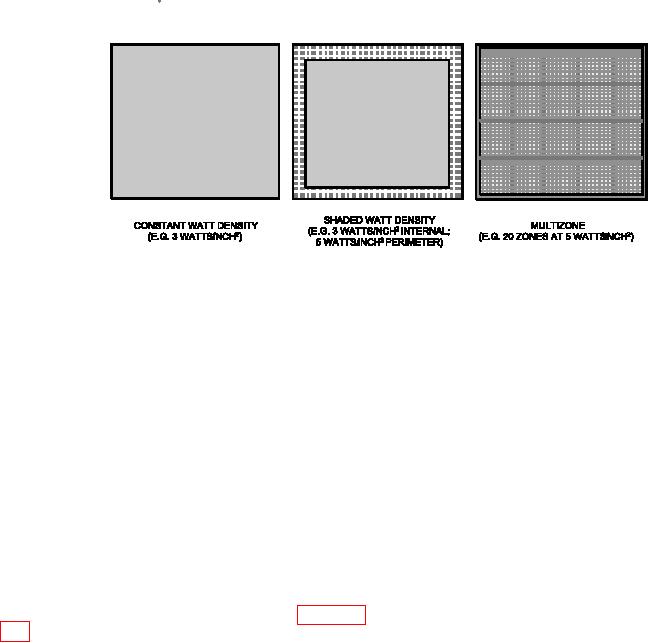
TM 1-1500-204-23-11
For example, excessive height in a core plug being
temperatures on the outer portion of the repair area
bonded into place causes a gap at the edges of the
to be less than the center. A shaded watt density
core plug and correspondingly inadequate heating at
heat blanket can minimize the temperature variation
the plug s edge. In addition, heat loss occurs around
by providing higher heat capacity at the edges.
the outer perimeter of the heat blanket causing the
Figure 3-2. Heat Blanket Coniguration
(1) Standard Heat Blankets. Standard heat
the voltage and wattage of the blanket. Using this
blankets can be used for most ield repairs up to
information we can calculate its nominal resistance.
400 F. These consist of electrical heating elements
The formula for calculating the resistance (R) of a
embedded between plies of silicone material. They
circuit is: R=V W, where V is voltage and W is
are available in standard sizes and use a constant
watts. Therefore, if a heat blanket s markings say
watt density across the blanket, typically 5 watts per
that it is rated for 120 volts and 720 watts, we can
square inch. These heat blankets are lexible and
calculate the nominal resistance as follows: R = 120
can usually be formed to part contours of 0.50 inch
720 R =14,400720 R = 20 Ω All other things
or larger.
being equal, the resistance through this heat blanket
should be 20 ohms, or 20Ω. If we allow a 5%
deviation for normal wear and tear we can then say
(2) Special Heat Blankets. Special heat blan-
that this heat blanket should have a resistance range
kets are available and may be required to provide
of 19Ω to 21Ω. It is recommended that the range
even heating of repairs. The shaded watt density
be calculated for all heat blankets in the shop and
blanket provides extra heat near the edge band; it is
written on them at the bus with indelible ink. That
good for repairs near the edge of a panel or where
way, technicians need only perform a quick resistance
there is lack of space for the heat blanket to overlap
check on any heat blanket to verify that it will operate
the repair. A multizone heat blanket can be designed
satisfactorily prior to running a cure.
for speciic applications requiring unique shapes or
watt densities to overcome heat sinks (see paragraph
i. Thermocouples. A thermocouple (TC) is a
6-18g, Thermal Survey). Some blankets have varying
watt density, some have separate heating zones, and
thermoelectric device used to accurately measure
some incorporate a vacuum capability. Heat blankets
temperatures. They may be connected to a simple
for hazardous locations (light line) may include over
temperature reading device or, more often, they are
temperature safety devices and faulty circuit sensors.
connected to a hot bonder, oven or other type of
See the system speciic technical manual to verify if
controller which regulates the amount of heat applied
a special heat blanket is required for your repair.
to the repair area. TCs consist of a wire with two
leads of dissimilar metals; the metals are joined at one
end. Heating the joint produces an electric current;
(3) Heat Blanket Testing. While some equip-
this current is converted to a temperature reading with
ment is available commercially that "tests" heat blan-
a TC monitor. Select the type of wire (typically J)
kets, most defects can easily be detected using a
and the type of connector (standard or miniature) that
common multimeter. When the NiChrome wire ele-
are compatible with the local temperature monitoring
ments in a heat blanket become stretched and thin, or
equipment (hot bonder, heat gun, etc.). TC wire
when they break it changes the overall electrical resis-
is available with different types of insulation; check
tance of the blanket. All heat blankets are stamped
the manufacturer s product data sheets to ensure the
at the bus area with the manufacturer s name, and

